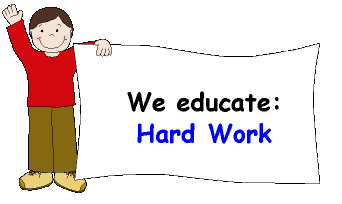|
One says that a hardworking person is the one that applies himself to work. This is a quality that can be educated from an early age, either in the early childhood center or in the family. In the early childhood center this quality can be worked on in all the activities and processes in which the children participate, we can also plan activities with this specific aim, for example, collective works with a social aim, small tasks, work in nature (care of plants, little animals and the surroundings of the early childhood center). Tasks can be programmed, which in some educative systems can be called shifts or duties, through which the child helps his educator to tidy up the class, to hand out materials, etc. These activities can foster the development of diverse contents, such as the relations of cooperation and the feelings of admiration and respect for the work of the adults. It is important to emphasize that the work at this age does not mean the necessity to create a product but that it has as a main target to contribute to the integral formation of the children. The activities offer the children ample possibilities of doing different actions, of using diverse tools and to take care of them, in addition when doing tasks of this type they get used to having responsibility in their fulfilment and get to understand the necessity of typical tasks at home and in the early childhood center, such as, to help to lay the table cloths and the napkins, to help to clean the tables and chairs, to tidy up the toys and to order them, to clean the class, to organize the class and the toy place, to maintain the corners clean, etc. For this purpose, we need in a very special way the contribution of the family, in order to provide a systematic influence and the educational consistency that ensures the fulfilment of the proposed objectives, for this reason, from the first days of the course it is necessary that the parents know what their children must achieve and how they can collaborate. In a general sense the activities at this age will be directed so that the children feel pleasure just for giving help, for their work and for being useful, so it is necessary to make them understand that work is not the same as play and that they have begun an important task that they must complete. An important aspect that we always have to consider is the example of the adult that constitutes the fundamental method in the moral and working education, the way in which one acts, the sensitivity and the pedagogical tact that one has to have to deal with children that will be the key to the success of our work. The contact in the real situations is the best route to approach these contents and assess the development reached by the children. The diligence, as a characteristic of the personality, makes the tenacity, the care and the patience possible in the child, indispensable things to make the school tasks, and a hardworking child usually makes his works in a beautiful and pretty way. The diligence, in the adults, is the source of a creative worker, because almost all scientists and inventors are hard-workers. |
ACTIVITY
No 1 |
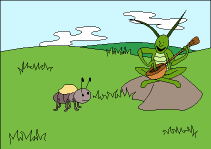 |
Summary of the activity: The educator will read the story "The cicada and the ant" and after that, he will ask questions to the children, in a second part they will hold an ethical conversation on the subject of diligence. The third part of the activity consists of the projection of a film, or videotape or an exhibition of pictures on the life of the ants. Objectives: To develop in the children knowledge about diligence Procedures:
Material Resources: Story book, pictures or video film or CD, video equipment or a computer.
Development of the activity:
The
educator will ask the children:
2nd Part The
educator will read the fable again and will ask the children the following
questions: We are going to talk about something very pretty that is called "Diligence". "The hardworking people and animals apply themselves to their work, they are like the little ant of the fable, and we must be all like this". The educator will give examples of hardworking people that can be the children’s parents, the school workers, etc. Next
he will comment: "Because your parents are hardworking you have toys, clothes, food, and it does not happen to you like the cicada." "Thanks to the diligence of the construction workers (bricklayers, carpenters, etc.); you have a cosy small house to live." "There are many people in the world who work for children, for example: the doctors and nurses work so that the children who are ill get healed." "The
teachers so that the children learn, In this way the educator will give all the examples that he thinks are suitable, and to end he will tell the children: "Like all these people who work so that the children live happily, it is necessary that you understand that we have to respect the work of the adults, you can also help your parents with small tasks at home, the teacher and the workers at school, taking care of cleaning, ordering and tidying up the work materials when you finish the activities, etc."
3rd Part |
CRITERIAL
ASSESSMENT |
|||
Observed
conduct |
YES |
NO |
Comments |
Through
their expressions the children did not show to have understood what
diligence means. |
|||
They
understood the importance of others’ work. |
|||
ACTIVITY
No 2 |
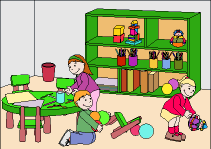 |
Objectives: That the children feel satisfaction for the accomplishment of collective works. Procedures: Material Resources: Cloth for cleaning, basin with water, cleaning equipment appropriate to the size of the children, they can be little brushes and toy mops.
Development of the activity: The educator will explain to the children the objective of this collective work and will even distribute the tasks or responsibilities taking one for him, as his example will serve as a model to the children. The educator will distribute the tasks considering the skills that each one of the children must be able to develop successfully; he will also have to consider that these are tasks that the child can do according to his physical possibilities or the skills needed for its accomplishment.
2nd Part He will also explain that through this work we can have a pretty classroom and that it will be necessary for everybody to cooperate so that it always stays clean and pretty, for example, by not throwing papers or waste to the ground, cleaning and tidying up the work table when the activity is done, because in this way they help everybody and the person who cleans the classroom. |
CRITERIAL
ASSESSMENT |
|||
Observed
conduct |
YES |
NO |
Comments |
They
fulfilled the tasks entrusted in the collective work until the end. |
|||
They
showed conducts of respect and cooperation towards other people's work
(to take care of the cleaning of the centre, etc.). |
|||
They
recognized the help given to the workers of their school. |
|||
They
were glad with the result of their work. |
|||
ACTIVITY
No 3 |
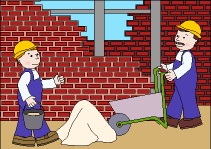 |
Summary of the activity: The children will take a stroll to a construction site near the school and will observe the work that the workers do, they will be able to talk with them and to ask them questions about their work, finally the teacher will talk with the children about what they observed and listened to in the visit. Objectives: That the children know the usefulness of the work of the people who work as construction workers. Procedures:
Material Resources: A camera or camcorder could be used in case they want to take photos and make a film about the stroll, paper, paintings, glue, stickers, fine cardboard, scissors, etc.
Development of the activity: We will talk with the children about the place to visit and what they will observe there. Next the children will make tokens for the workers, for example: a poster, cards, drawings, book markers, etc.
2nd Part
3rd Part If photos or films have been taken, they will be shown or projected so that the children observe them before the conversation. |
CRITERIAL
ASSESSMENT |
|||
Observed
conduct |
YES |
NO |
Comments |
They
expressed and imitated in their games and activities what they observed
in the visit. |
|||
They
showed expressions of admiration and respect towards the builders’
work. |
|||
They
recognized the utility of other people's work. |
|||
ACTIVITY
No 4 |
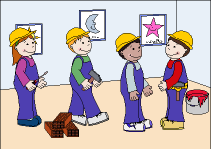 |
Summary of the activity: This is a role play in the theme "The builders" and the participants will be all the boys and girls who wish to take part in it. Objectives: To develop in the child experiences about the construction workers’ diligence. Procedures:
Material Resources: A play corner where there are the necessary things so that the children can portray the construction workers: crash helmets, plastic blocks of great size and some toy tools, like wheelbarrows, shovels, bricklayer spoon, etc.
Development of the activity: In the course of this conversation the educator will ask questions to the children so that they describe their experiences about what they saw and listened in the stroll about the construction workers’ efforts.
2nd Part
3rd Part Finally the educator will summarize the conversation summarizing what was learnt about diligence and how we need the work of many people to be able to feed us, to dress us, to live in comfortable houses, to have theatres, parks, schools, etc. |
CRITERIAL
ASSESSMENT |
|||
Observed
conduct |
YES |
NO |
Comments |
They
developed the argument of the game until the end. |
|||
They
developed the actions corresponding to the role carried out. |
|||
They
made comments about the importance of the builders’ work. |
|||
They
knew how to solve the conflicts arisen during the game. |
|||
They
needed the educator’s help to solve the conflicts arisen during
the game. |
|||
ACTIVITY
No 5 |
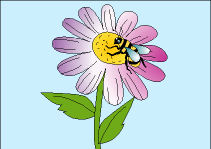 |
Summary of the activity: This is a motion game that can be played in an outer area where there are plants with flowers, or in an inner area where one simulates a garden with plants and flowers. The children will simulate with their movements the bees sucking the flowers. In the first part the educator will explain the rules of the game to them, in the second part of the activity he will speak and show pictures to them about the bees and he will explain why they are so hardworking. Finally the children will play the game. Objectives: To develop in the child positive emotions about the diligence of the bees. Procedures:
Material Resources: Natural or artificial plants and flowers, apicultural products like: honey, a piece of wax, pictures with bees, for example: sucking the flower, landing on the honeycomb, the larva of a bee, etc. If the teacher does not have a garden in the school and he cannot do the activity in a park either, or he is going to do the activity in a season of the year in which the plants do not bloom, he can prepare a circuit with plants drawn on a fine cardboard or cardboard cut out and put each one at a certain distance from the other, and he will draw flowers in some of them and not in the others.
Development of the activity: The winners will be the children who do all the movements (to run, to stop, to breathe in deeply, to tiptoe around the plant, and to bend towards it) and who in addition stop and do the movements only before the plants with flowers. In the garden or park there surely are plants with flowers and others that do not have them, if the child stops in front of a plant that does not have flowers, he will not be the winner. Each child will cross the garden only once.
2nd Part He will tell them that the bees are very hardworking insects, that they live in colonies, where there are many workers, a queen bee and several drones. The queen bee is the one that leads the beehive, she is something similar to the headmistress, she is the one that lays many, many eggs, that soon become larvae (he will show a photo or engraving of a larva) that the working bees feed. The working bees secrete wax, they construct the honeycomb, they gather nectar, pollen and water, they transform the nectar into honey, they clean the beehive (To show an engraving of the worker in the honeycomb), and they feed the larvae. While they fly from flower to flower, the workers gather pollen in a special bag located in one of their back legs (Picture of a bee where the back legs are seen). The pollen, main food source, is necessary for the development of the queen, the worker and the drones. The bees introduce the pollen in the cells of the larvae when they return to the beehive and they also turn the nectar that they suck in the flowers into honey. The bee that produces honey (working) is recognized as the most valuable insect not only by the value of honey and wax that it produces but in addition, because its main utility is its polinization role (to take the pollen from a plant to another so that it germinates and has fruits) of the cultures of fruits, nuts, fodder vegetables and vegetables, as well as non cultivated plants that prevent the erosion of the ground fixing it and preventing it from being dragged to the oceans. The drone bee lacks a sting and has no defence; it does not have a small basket for the pollen nor wax producing glands, and it cannot secrete jelly. Therefore it does not work, for that reason people who do not work is called "drones".
3rd Part To conclude, the educator can show honey, a piece of honeycomb, wax, that is apicultural products that he can obtain, and they will taste them in group, emphasizing that they are available thanks to the diligence of the bees. He
will ask the following questions to the children: |
CRITERIAL
ASSESSMENT |
|||
Observed
conduct |
YES |
NO |
Comments |
They
made the movements of the game correctly. |
|||
They
observed the rules of the game. |
|||
They
answered the questions suitably. |
|||
They
showed positive emotions on the diligence of the bees. |
|||
They
showed interest and willingness to be like the working bee or the
queen. |
|||
ACTIVITY
No 6 |
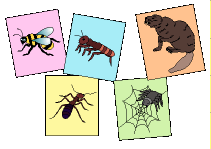 |
Summary of the activity: In the first part of the activity we explain to the children and we show pictures on the characteristics of hardworking animals, in the second part a conversation will be held on the diligence of these animals. Objectives: To develop in the child knowledge on the diligence of those animals that are characterized by this quality. Procedures:
Material Resources: Pictures or photos of the beaver, the spider, the bee, the ant, the termite.
Development of the activity: If the children do not remember everything, the educator will add what is missing on what was spoken about these little animals in the previous activities. The
bee: The children describe it because they already know it.
2nd Part The beaver: The beavers live next to the rivers and lakes surrounded by wooded zones and they work untiringly to make their burrow or nests that consist of a species of construction formed by woods, branches, grass and interwoven moss, and they have a central chamber to which they enter under the water. The beaver repairs the burrow continuously which grows in size year after year. Another type of burrows are simple tunnels excavated in the borders of the rivers and lakes. He also constructs dikes to dam and to elevate the level of the water around the burrow where it lives. The dikes are constructed with the most solid woods and trunks, and with mud, weeds and stones. The beaver repairs and adds materials to the dam or dike in a continuous way. He will ask the children: Do you think that the beaver is a hardworking animal? Why?
3rd Part The termites: They live in the forests, in colonies formed by reproducers, workers and soldiers. The workers construct the nest and feed and take care of the laying female, which has a great size, and of the other members of the colony. The soldier termites protect the colony and the reproductive pair guarantees a continued production of thousands of eggs, from which the termites are later born, for that reason they are called reproducers. Next he presents the picture of the weaving spider and explains its characteristics. The weaving spider: It weaves and weaves its web untiringly with a substance that it secretes, which you can see in some corners of the walls. It inhabits forests and gardens, and thanks to the spider web that it builds, it hunts the insects on which it is fed. To end, the teacher asks the children if they consider the termites and the weaving spider hardworking little animals and why. Regarding all the questions asked in the different parts of the activity, if some answers are not correct, the educator will give the necessary help, so that the children understand clearly the diligence of these little animals. |
CRITERIAL
ASSESSMENT |
|||
Observed
conduct |
YES |
NO |
Comments |
They
recognized these animals as hardworking. |
|||
They
knew to discuss the answers of why they are hardworking |
|||
ACTIVITY
No 7 |
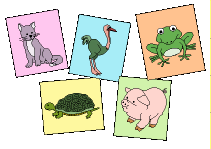
|
Summary of the activity: In this activity the children will choose between two animals the one that is the most hardworking, later they will discuss why they selected it as the most hardworking. Objectives: To verify if the children are able to discriminate a diligence model and to discuss their selection. Material Resources: Several engraving games that will contain images of the following animals: Bee, ant, turtle, spider, beaver, pig, cat, frog, termite, ostrich.
Development of the activity: Once the child answers, if there are any mistakes when selecting the little animal the educator will give the floor to another child who has raised the hand so that he answers it. Later he will ask the rest of the group if they agree with the answer given, if it is missing something and if anybody wants to say something more.
2nd Part
3rd Part
4th Part
5th Part Finally the educator will value with the children their answers. |
CRITERIAL
ASSESSMENT |
|||
Observed
conduct |
YES |
NO |
Comments |
They
made the selection well. |
|||
They
selected with help. |
|||
They
knew how to discuss their selection. |
|||
They
discussed their selection with help. |
|||


